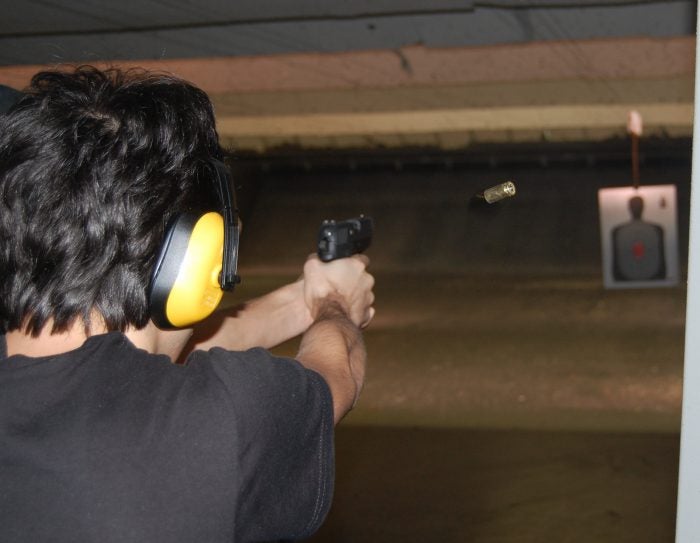A Handgun Shooting Drill to Improve Accuracy
Rob Reed 07.04.17

One of the common handgun shooting errors are shots that go left or low-left for a right-handed shooter. This is the result of the shooter pulling the gun off-target as they pull the trigger. (For left-handed shooters the results are right and low-right).
The exact reason they pull the gun of target might be because they are moving the gun in anticipation of recoil or because of poor follow through. Whatever the specific cause this problem is typically described as “flinch.”
As an instructor I’ve found a drill to help students break this habit and improve their accuracy. It’s important to note that this is a slow-fire drill designed to improve the shooter’s mastery of the fundamentals of handgun marksmanship. Shooting the drill quickly, drawing from a holster, or treating this as a “tactical” drill in any other way will actually be counter-productive.
The fix does require some advance preparation. The shooter needs to set up a safe dry-fire area at home and put in some homework before heading to the range. (Make sure to follow all dry-fire safety rules including using a backstop that would stop bullets and not having any live ammo in the room).
I call this the “Five minutes, five yards, five days” drill.
Dryfire at home:
- Set a target at five yards with a 1″ aiming point.
- Do five minutes of dry-fire practice a day, for five days.
- At each practice focus on the front sight and work to pull the trigger until the gun goes “click” without pulling the front sight off of the small aim point.
- You can place an empty case at the edge of the slide to help you work on trigger control. Try to “fire” the gun without making the case fall.
- Work to maintain sharp focus on the front sight throughout the process.
- After five days of five minutes of dry-fire a day it’s time to head to the range.
At the range
Set a target at five yards with a 1″ aiming point. (It’s best if you use an identical target).
Before you load up and shoot do five perfect dry-fire reps.
Work to not disturb the sight alignment while pulling the trigger and maintain sharp focus on the front sight throughout the process.
After five perfect dry-fire reps immediately load up five rounds and fire a precisely aimed shot at the aiming point. Make sure to keep your front sight in sharp focus and work to not pull the gun off target while pulling the trigger.
Do NOT look at the target to check the shot. Instead try to track the front sight during recoil (it takes practice) and immediately place the front sight back on the 1″ aiming point.
When you are ready fire the remaining four slow-fire, precisely aimed, shots. Aim at the same 1″ aiming point for every shot. Do NOT attempt to “move the hits to the bullseye” or otherwise change your aim point. You are shooting for a group here and you need a consistent aim point for every shot in order to analyze your shots.
By immediately placing the front sight back on the aiming point you improve your follow through. If you immediately look for the bullet hole after every shot there is a tendency to crane your neck up to look for the hole while simultaneously pulling the gun down before the bullet has left the barrel. This will pull shots low.
After the first five shot live-fire group, perform another five dry-fire shots, than fire another five live-fire shots. By interspersing the dry-fire with live-fire you train yourself to eliminate flinch. By firing a maximum of five shots at a time you make it easier to keep mental focus on your shooting through out the drill. I usually recommend no more than 20 or 25 live fire shots be fired for the whole drill due to the cumulative effects of fatigue.
To see how this improves your shooting fire a five shot group at five yards before you start this practice method and then compare it to the best five shot group you achieved after trying this drill.
As you skill improves you can move the target back. I recommend seven yards and then 10 yards. Conversely, if you or a new shooter you are coaching are struggling, move the target up to three yards.